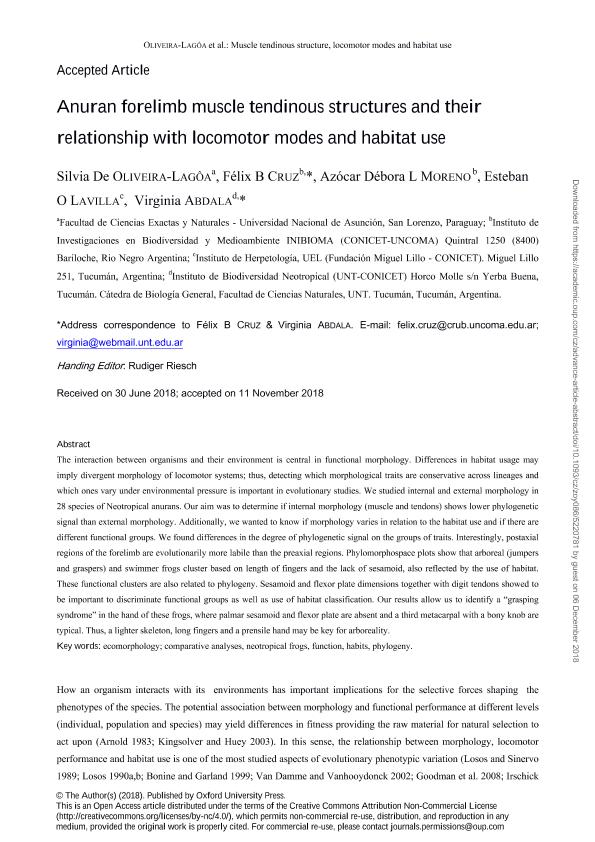Mostrar el registro sencillo del ítem
dc.contributor.author
De Oliveira Lagôa, Silvia
dc.contributor.author
Cruz, Felix Benjamin

dc.contributor.author
Moreno Azócar, Débora Lina

dc.contributor.author
Lavilla, Esteban Orlando

dc.contributor.author
Abdala, Virginia Sara Luz

dc.date.available
2019-10-17T15:53:54Z
dc.date.issued
2018-11
dc.identifier.citation
De Oliveira Lagôa, Silvia ; Cruz, Felix Benjamin; Moreno Azócar, Débora Lina; Lavilla, Esteban Orlando; Abdala, Virginia Sara Luz; Anuran forelimb muscle tendinous structures and their relationship with locomotor modes and habitat use; Oxford Academic; Current Zoology; 65; 5; 11-2018; 1-10
dc.identifier.issn
1674-5507
dc.identifier.uri
http://hdl.handle.net/11336/86152
dc.description.abstract
The interaction between organisms and their environment is central in functional morphology. Differences in habitat usage may imply divergent morphology of locomotor systems; thus, detecting which morphological traits are conservative across lineages and which ones vary under environmental pressure is important in evolutionary studies. We studied internal and external morphology in 28 species of Neotropical anurans. Our aim was to determine if internal morphology (muscle and tendons) shows lower phylogenetic signal than external morphology. In addition, we wanted to know if morphology varies in relation to the habitat use and if there are different functional groups. We found differences in the degree of phylogenetic signal on the groups of traits. Interestingly, postaxial regions of the forelimb are evolutionarily more labile than the preaxial regions. Phylomorphospace plots show that arboreal (jumpers and graspers) and swimmer frogs cluster based on length of fingers and the lack of sesamoid, also reflected by the use of habitat. These functional clusters are also related to phylogeny. Sesamoid and flexor plate dimensions together with digit tendons showed to be important to discriminate functional groups as well as use of habitat classification. Our results allow us to identify a ?grasping syndrome? in the hand of these frogs, where palmar sesamoid and flexor plate are absent and a third metacarpal with a bony knob are typical. Thus, a lighter skeleton, long fingers and a prensile hand may be key for arboreality.
dc.format
application/pdf
dc.language.iso
eng
dc.publisher
Oxford Academic
dc.rights
info:eu-repo/semantics/openAccess
dc.rights.uri
https://creativecommons.org/licenses/by-nc-sa/2.5/ar/
dc.subject
comparative analyses
dc.subject
rcomorphology
dc.subject
neotropical frogs
dc.subject.classification
Biología

dc.subject.classification
Ciencias Biológicas

dc.subject.classification
CIENCIAS NATURALES Y EXACTAS

dc.title
Anuran forelimb muscle tendinous structures and their relationship with locomotor modes and habitat use
dc.type
info:eu-repo/semantics/article
dc.type
info:ar-repo/semantics/artículo
dc.type
info:eu-repo/semantics/publishedVersion
dc.date.updated
2019-10-16T19:13:00Z
dc.journal.volume
65
dc.journal.number
5
dc.journal.pagination
1-10
dc.journal.pais
Reino Unido

dc.journal.ciudad
Londres
dc.description.fil
Fil: De Oliveira Lagôa, Silvia. Universidad Nacional de Asunción; Paraguay
dc.description.fil
Fil: Cruz, Felix Benjamin. Consejo Nacional de Investigaciones Científicas y Técnicas. Centro Científico Tecnológico Conicet - Patagonia Norte. Instituto de Investigaciones en Biodiversidad y Medioambiente. Universidad Nacional del Comahue. Centro Regional Universidad Bariloche. Instituto de Investigaciones en Biodiversidad y Medioambiente; Argentina
dc.description.fil
Fil: Moreno Azócar, Débora Lina. Universidad Nacional del Comahue. Centro Regional Universitario Bariloche; Argentina
dc.description.fil
Fil: Lavilla, Esteban Orlando. Consejo Nacional de Investigaciones Científicas y Técnicas. Centro Científico Tecnológico - Tucumán. Unidad Ejecutora Lillo; Argentina
dc.description.fil
Fil: Abdala, Virginia Sara Luz. Consejo Nacional de Investigaciones Científicas y Técnicas. Centro Científico Tecnológico Conicet - Tucumán. Instituto de Biodiversidad Neotropical. Universidad Nacional de Tucumán. Facultad de Ciencias Naturales e Instituto Miguel Lillo. Instituto de Biodiversidad Neotropical. Instituto de Biodiversidad Neotropical; Argentina
dc.journal.title
Current Zoology
dc.relation.alternativeid
info:eu-repo/semantics/altIdentifier/url/https://academic.oup.com/cz/advance-article/doi/10.1093/cz/zoy086/5220781
dc.relation.alternativeid
info:eu-repo/semantics/altIdentifier/doi/https://doi.org/10.1093/cz/zoy086
Archivos asociados
